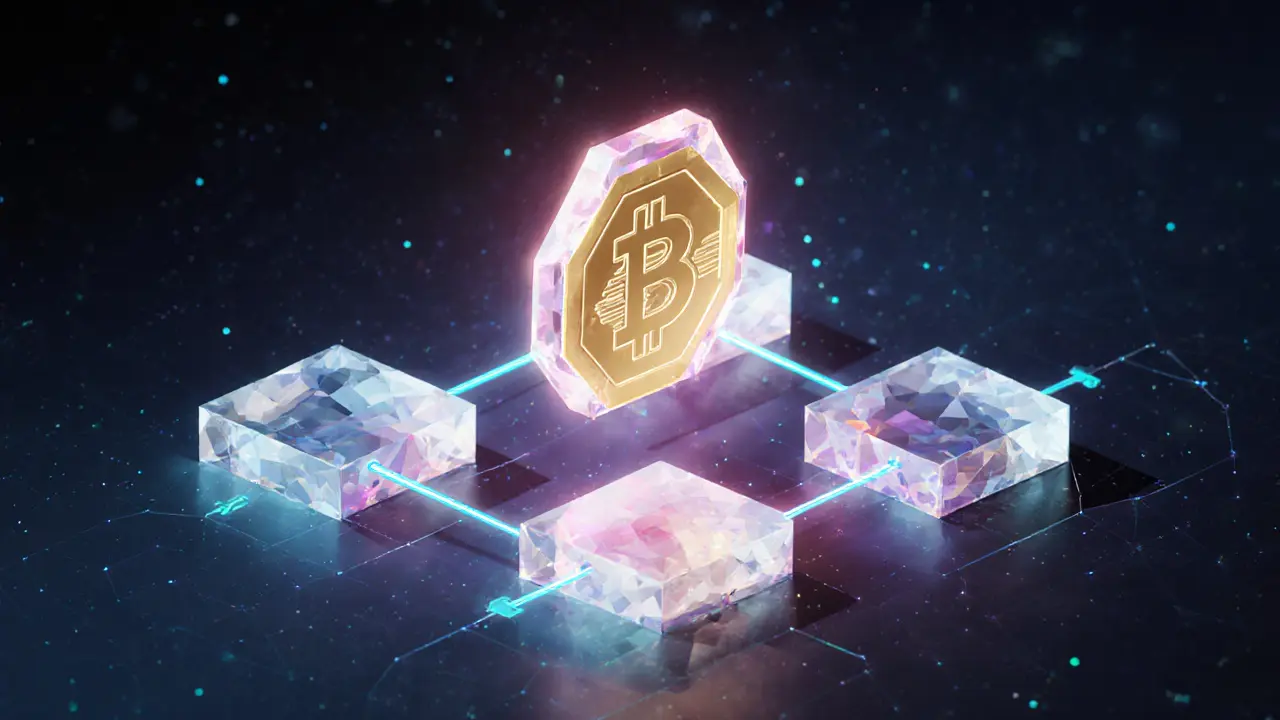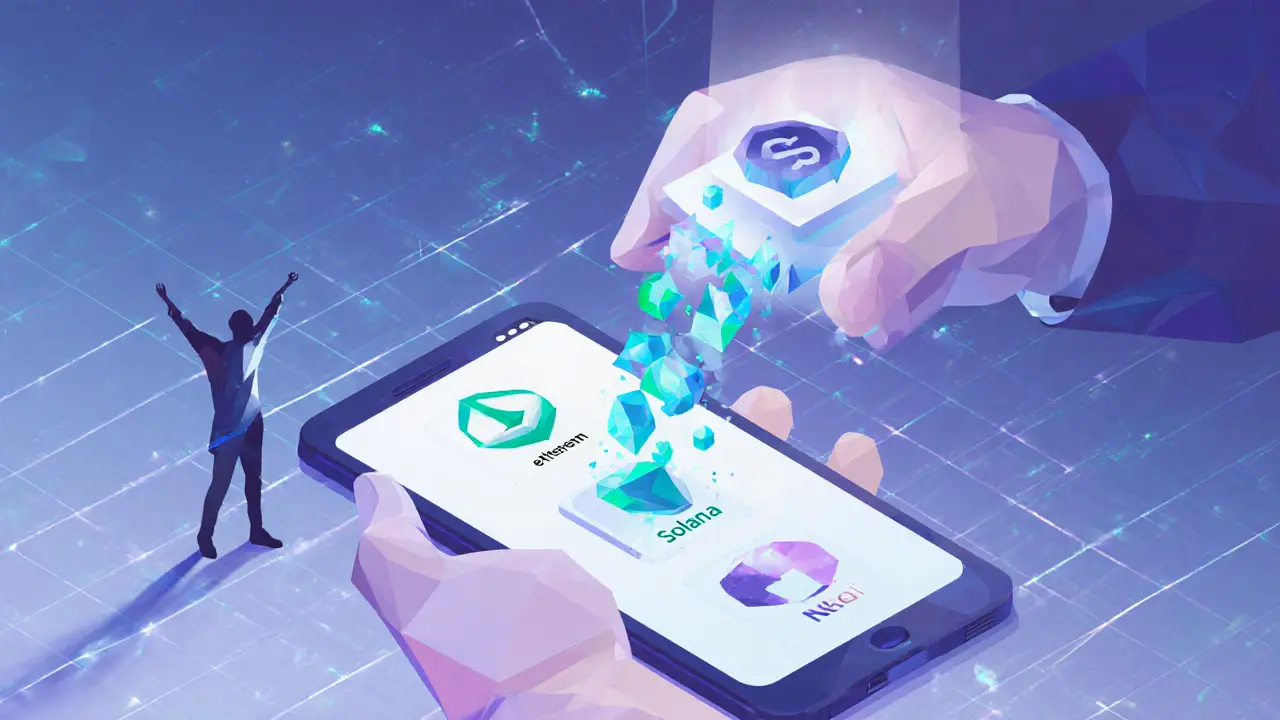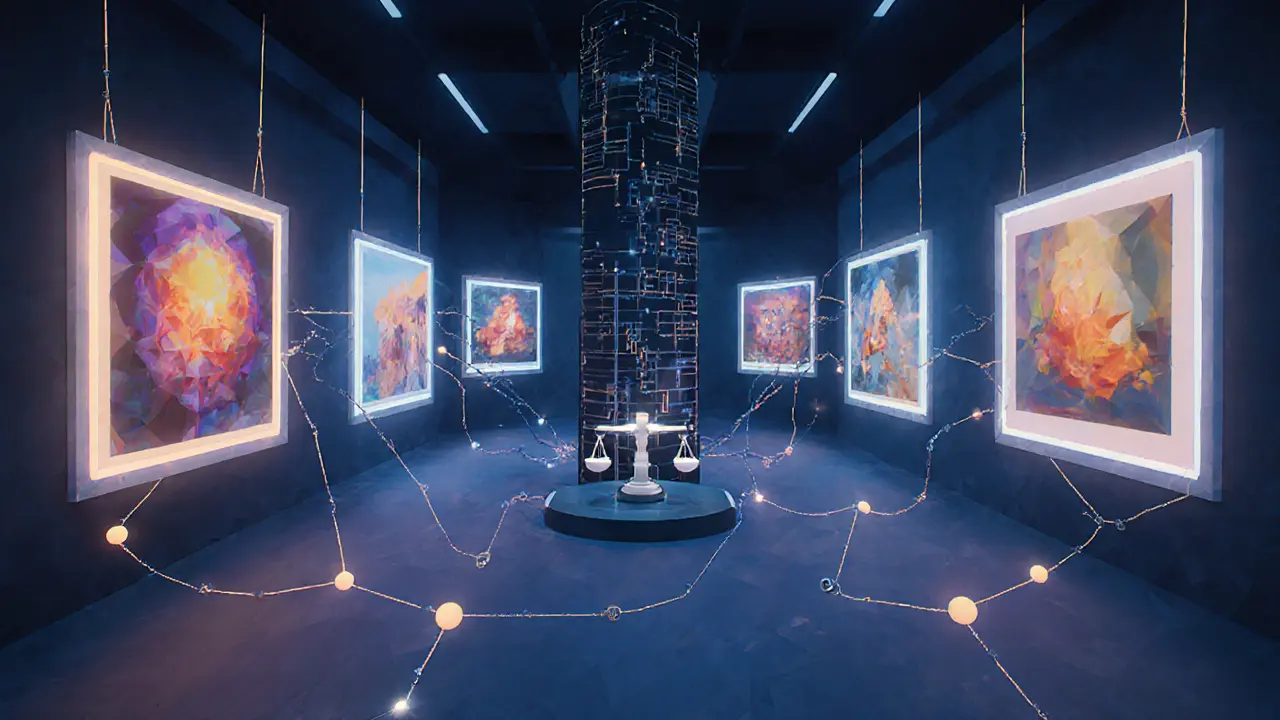Understanding NFT Provenance: How Ownership History Powers Digital Collections
 Mar, 4 2025
Mar, 4 2025
NFT Provenance Checker
Click "Simulate Ownership Chain" to generate a provenance report for your NFT.
When you buy a digital artwork, how can you be sure it’s the real thing and that the seller actually owns it? The answer lies in NFT provenance - a tamper‑proof ledger that records every transfer from the moment the token is minted. This article unpacks what NFT provenance is, why it matters, and how creators and collectors can harness it to protect value in the fast‑growing world of digital collectibles.
TL;DR
- NFT provenance records every ownership change on a blockchain, giving an unforgeable history.
- Minting creates a unique token using standards like ERC‑721, ERC‑1155, SPL or NEP‑171.
- Smart contracts automate royalties and transfers, ensuring creators earn on secondary sales.
- Provenance boosts trust, reduces fraud, and adds market value to digital art.
- Future use cases span real‑estate deeds, concert tickets, and cross‑chain asset tracking.
What Exactly Is NFT Provenance?
NFT provenance is the complete, immutable ownership history of a non‑fungible token recorded on a blockchain ledger. Every time the token moves - whether from creator to first collector, or through multiple secondary sales - the transaction is logged in a block that cannot be altered. This makes it possible to trace the token back to its origin, verify authenticity, and see all past owners at a glance.
How Does Provenance Get Recorded?
The process starts with minting the act of creating a new NFT on a blockchain, assigning it a unique identifier and metadata. Minting involves several steps:
- Select a blockchain network - most creators choose Ethereum a public, permissionless blockchain known for its robust smart‑contract capabilities, though alternatives like Solana a high‑throughput blockchain with low transaction fees and Polygon an Ethereum Layer‑2 solution offering faster, cheaper transactions are gaining traction.
- Choose a token standard. The most common are ERC‑721 a standard for unique, indivisible NFTs on Ethereum and ERC‑1155 a multi‑token standard that can handle both fungible and non‑fungible assets in a single contract. On Solana, the SPL standard serves a similar purpose for NFTs, while NEP‑171 is the native NFT standard on the NEAR blockchain.
- Upload the digital file (artwork, video, audio) to a marketplace like OpenSea one of the largest NFT marketplaces supporting multiple blockchains or Rarible a decentralized platform that lets creators set royalties directly in the smart contract.
- Define royalty percentages. Smart contracts automatically enforce these, sending a cut of every resale back to the creator.
- Submit the transaction. Once miners/validators confirm the block, the NFT and its provenance data become permanent.
Every subsequent transfer triggers a new transaction that appends to the chain, keeping the provenance chain continuous and transparent.
Token Standards and Interoperability
Different blockchains use slightly different standards, but they all aim to achieve the same goal: a unique identifier tied to immutable metadata. Below is a quick comparison of the most widely used standards.
| Standard | Blockchain | Unique ID? | Supports Fungible Tokens | Typical Use Cases |
|---|---|---|---|---|
| ERC‑721 | Ethereum | Yes | No | Digital art, collectibles |
| ERC‑1155 | Ethereum | Yes | Yes | Gaming items, mixed asset packs |
| SPL | Solana | Yes | No | High‑volume art drops, NFTs with low fees |
| NEP‑171 | NEAR | Yes | No | Community‑driven projects, low‑cost mints |
Because these standards are open‑source, developers can build bridges that let an ERC‑721 token appear on a Solana marketplace, preserving its provenance across chains. Interoperability is still evolving, but the foundation is solid enough for multi‑chain collectors to trust the history of their assets.

Why Provenance Beats Traditional Authentication
Before NFTs, art historians relied on paperwork, expert opinions, and provenance certificates that could be lost or forged. With blockchain a decentralized ledger that records transactions in immutable blocks, every sale, auction, or private transfer is publicly visible. This transparency does three things:
- Eliminates forgery. A fake piece cannot claim a history that doesn’t match the blockchain entries.
- Speeds up verification. Buyers simply check the token’s transaction list on a block explorer instead of sifting through physical archives.
- Adds market value. Collectors are willing to pay a premium for items with a clear, unbroken lineage.
Smart contracts further enhance trust by enforcing royalty splits and automatically transferring ownership once payment is confirmed. No middleman can alter the terms after the fact.
Real‑World Use Cases Beyond Digital Art
While pixel art and 3D models dominate headlines, the provenance model extends to many other domains:
- Real‑estate deeds. Platforms like Provenance Blockchain use a Scope data structure a modular metadata module that stores ownership and asset details on‑chain while keeping personal data off‑chain to record land titles.
- Concert tickets. NFT tickets carry a verified ownership trail, making scalping detectable and resale royalties possible.
- In‑game items. Games built on ERC‑1155 can prove that a rare sword originated from a limited‑edition drop, increasing its resale price.
- Financial instruments. Some DeFi platforms tokenize loans as NFTs, allowing lenders to track repayment histories and collateral changes.
These examples show how provenance can secure anything that needs a trustworthy ownership record, whether it lives on‑chain or represents a physical asset.
Market Size and Transaction Volume
Data from Nadini etal. (2021) recorded more than 6.1million NFT transactions across six major platforms, highlighting that provenance systems are already handling massive scale. Recent 2024 reports show daily mint volumes exceeding 100,000 tokens on Ethereum alone, with a total market cap hovering around $30billion. These figures demonstrate that provenance isn’t a niche feature - it’s the backbone of a multi‑billion‑dollar ecosystem.
Future Directions
As the technology matures, several trends will make provenance even more powerful:
- Cross‑chain bridges. New protocols will allow an NFT created on Ethereum to retain its original transaction history when moved to Polygon or Solana, preserving provenance across ecosystems.
- Layer‑2 scaling. Solutions like Base and Arbitrum will lower gas fees, making frequent provenance updates (e.g., for fractional ownership) cheaper.
- Legal integration. Governments are exploring how blockchain‑based records can serve as admissible evidence for property disputes, potentially recognizing NFT provenance as legal proof.
- Enhanced metadata standards. Future versions of ERC‑721 may embed richer provenance data (e.g., timestamps, geolocation) directly in the token, reducing reliance on external APIs.
All of these advances point to a future where every high‑value digital or physical asset carries an immutable, universally verifiable history.
Quick Checklist for Creators and Collectors
- Verify the token’s contract address on a reputable block explorer.
- Check the full transaction list - a gap may indicate a missing transfer.
- Confirm that royalties are encoded in the smart contract.
- Prefer platforms that display provenance data prominently (e.g., OpenSea’s “View Activity” tab).
- For high‑value assets, consider a third‑party audit of the smart contract code.

Frequently Asked Questions
What does NFT provenance actually record?
It records every mint, sale, transfer, and royalty payment linked to the token’s unique identifier, creating an immutable timeline that can be viewed on any block explorer.
Can provenance be edited or deleted?
No. Because the data lives on a blockchain, once a transaction is confirmed it becomes part of a permanent block that cannot be altered without rewriting the entire chain, which is computationally infeasible.
Do I need to understand code to verify provenance?
Not really. Most marketplaces show a clear activity log. For deeper checks, you can paste the contract address into Etherscan (or Solana Explorer) and review the transaction list.
How do royalties work with provenance?
Royalty percentages are stored in the smart contract at mint time. Each time the token changes hands, the contract automatically sends the specified cut to the creator’s address.
Is provenance useful for physical items?
Yes. By tokenizing a physical asset (like a deed or a luxury watch) and linking it to a digital certificate on‑chain, the NFT’s provenance becomes a verifiable record of ownership for that real‑world object.


Darren R.
March 4, 2025 AT 00:29When we speak of NFT provenance, we are really confronting the very soul of digital ownership; a tapestry woven with immutable threads, each transaction a moral imperative, each hash a beacon of truth-yet many wander blindly, as if the ledger were a myth, ignoring the ethical gravity that such transparency demands; consider the creator, whose rights are safeguarded by royalties encoded in steel, versus the opportunist who would peddle counterfeit copies; the blockchain does not merely record; it adjudicates, it disciplines, it reminds us that authenticity is not optional but sacred; thus, let us exalt provenance as the guardian of artistic integrity, lest we descend into a chaotic bazaar where value evaporates like vapor, and let every collector remember that their purchase is a covenant, not a mere transaction.
Hardik Kanzariya
March 6, 2025 AT 21:56I totally get how confusing provenance can feel at first, but once you dive in you’ll see it’s actually a helpful roadmap; just think of it as a friendly guide that shows you exactly where that piece has been, so you can feel confident you’re supporting the right artist.
Shanthan Jogavajjala
March 9, 2025 AT 19:23From a technical perspective, each transfer is a state transition recorded on‑chain, which means the provenance data structure is essentially a Merkle‑based linked list; when you query the contract address via an explorer you retrieve the sequential event logs, each containing the from‑address, to‑address, and timestamp, thereby constructing an immutable audit trail.
Millsaps Delaine
March 12, 2025 AT 16:49One must, with a measured yet impassioned tone, acknowledge that the discourse surrounding NFT provenance is not merely a peripheral curiosity but rather a paramount pillar of contemporary digital culture; the epistemic weight carried by each immutable record demands our utmost reverence, for it bestows upon the collector a lineage akin to the aristocratic pedigrees of bygone eras, thereby elevating the mere token to an artefact of historic significance. Moreover, the integration of royalty mechanisms within smart contracts serves as a veritable safeguard against the predatory exploitation that has historically plagued artistic domains; it ensures that creators continue to reap the benefits of their ingenuity even as their works traverse secondary markets, a fact that should be celebrated not merely as an economic incentive but as a moral rectitude. One cannot overlook, however, the nuanced challenges posed by interoperability, for as NFTs migrate across disparate chains the continuity of provenance may be jeopardized; it is imperative that developers prioritize bridge solutions that preserve transactional integrity. In sum, the provenance framework functions as both a ledger of authenticity and a guardian of artistic equity, inviting us to contemplate the broader implications of digital ownership in an increasingly tokenized world.
Jack Fans
March 15, 2025 AT 14:16Hey folks, just a quick tip-always double‑check the contract address on Etherscan or Solana Explorer before you buy; that way you can see the full activity log, confirm the royalty% is set, and catch any gaps that might suggest a missing transfer. Also, many marketplaces now have a “View Activity” tab that makes this super easy; it’s a small step that can save you a lot of hassle later on. If you’re dealing with cross‑chain NFTs, look for platforms that display provenance across bridges, as that keeps the history intact. Happy hunting!
-Jack
Adetoyese Oluyomi-Deji Olugunna
March 18, 2025 AT 11:43One should recognize the unparalleled stature that provenance confers upon digital artefacts; it's not just a ledger, it's a **symphony** of ownership that only the discerning elite can truly appreciate. By neglecting this, the uninformed risk devolving their acquisitions into mere trinkets, unworthy of scholarly discourse.
Krithika Natarajan
March 21, 2025 AT 09:09Just a gentle reminder to keep an eye on the activity tab; it’s a kind way to verify the token’s journey without any hassle.
Ayaz Mudarris
March 24, 2025 AT 06:36Dear community, it is incumbent upon us to approach NFT provenance with the rigor of an academic inquiry; by meticulously reviewing the immutable transaction history, we not only safeguard our investments but also uphold the principles of transparency that underpin the blockchain ethos. I encourage you all to employ reputable explorers, verify contract addresses, and familiarize yourselves with royalty clauses embedded within smart contracts, thereby ensuring that creators receive due compensation for their labor.
Irene Tien MD MSc
March 27, 2025 AT 04:03Oh great, another shiny NFT promising "authenticity"-as if the blockchain itself hasn't been infiltrated by secret cabals pulling strings behind the scenes. Provenance is just a fancy term for "we can trace who sold it to whom," which, let's be honest, doesn't stop the inevitable meme‑stock crash once the hype fizzles out. So enjoy your immutable ledger while it lasts; the next big scandal is probably already being minted.
Linda Welch
March 30, 2025 AT 01:29Honestly, all this talk about ownership history is just patriotic propaganda for the crypto elite, nobody really cares about who owned a pixel art before.
Kevin Fellows
April 1, 2025 AT 22:56Nice stuff-keep it simple and enjoy the ride.
meredith farmer
April 4, 2025 AT 20:23The drama surrounding provenance is nothing short of a theatrical performance; every transaction is a scene, every token a protagonist, and the audience-us-waits with bated breath for the next twist, all while questioning whether the script itself is a clandestine conspiracy hidden in code.
Lara Cocchetti
April 7, 2025 AT 17:49One must remain vigilant, for the allure of unchecked provenance can mask nefarious motives; let us not be seduced by glossy interfaces while overlooking the deeper moral implications of decentralized ownership.
Mark Briggs
April 10, 2025 AT 15:16Yep, looks like another overhyped feature.
mannu kumar rajpoot
April 13, 2025 AT 12:43It's curious how some collectors obsess over every transfer, as if the chain itself holds secret power; perhaps the real value lies not in the token but in the narrative we craft around it.
Tilly Fluf
April 16, 2025 AT 10:09May I kindly suggest that, when evaluating provenance, one also considers the broader cultural impact of the artwork, ensuring that its legacy aligns with responsible stewardship and respect for the originating community.
kishan kumar
April 19, 2025 AT 07:36Contemplating the immutable ledger, one perceives a philosophical echo of existence itself-each block a moment, each transfer a reminder of impermanence, yet bound by code. :)
Anthony R
April 22, 2025 AT 05:03For those seeking to verify provenance, a methodical approach is advisable: first, locate the token’s contract address; second, input it into a reputable blockchain explorer; third, examine the chronological list of events, noting timestamps, from‑and‑to addresses, and any royalty clauses embedded; this systematic process ensures confidence in authenticity and helps avoid potential pitfalls associated with counterfeit listings.
Vaishnavi Singh
April 25, 2025 AT 02:29Reflection upon the chain reveals a silent chronicle of exchange, each entry a humble testament to the continuity of ownership.
Andrea Tan
April 27, 2025 AT 23:56Sounds good! Just double‑check the activity log and you’re set.
Karl Livingston
April 30, 2025 AT 21:23When I look at the provenance data, I’m reminded of an old proverb: a chain is only as strong as its weakest link. By ensuring each transfer is logged transparently, we protect both creators and collectors, fostering a healthier ecosystem where trust isn’t just a buzzword but a verifiable reality.
-Karl